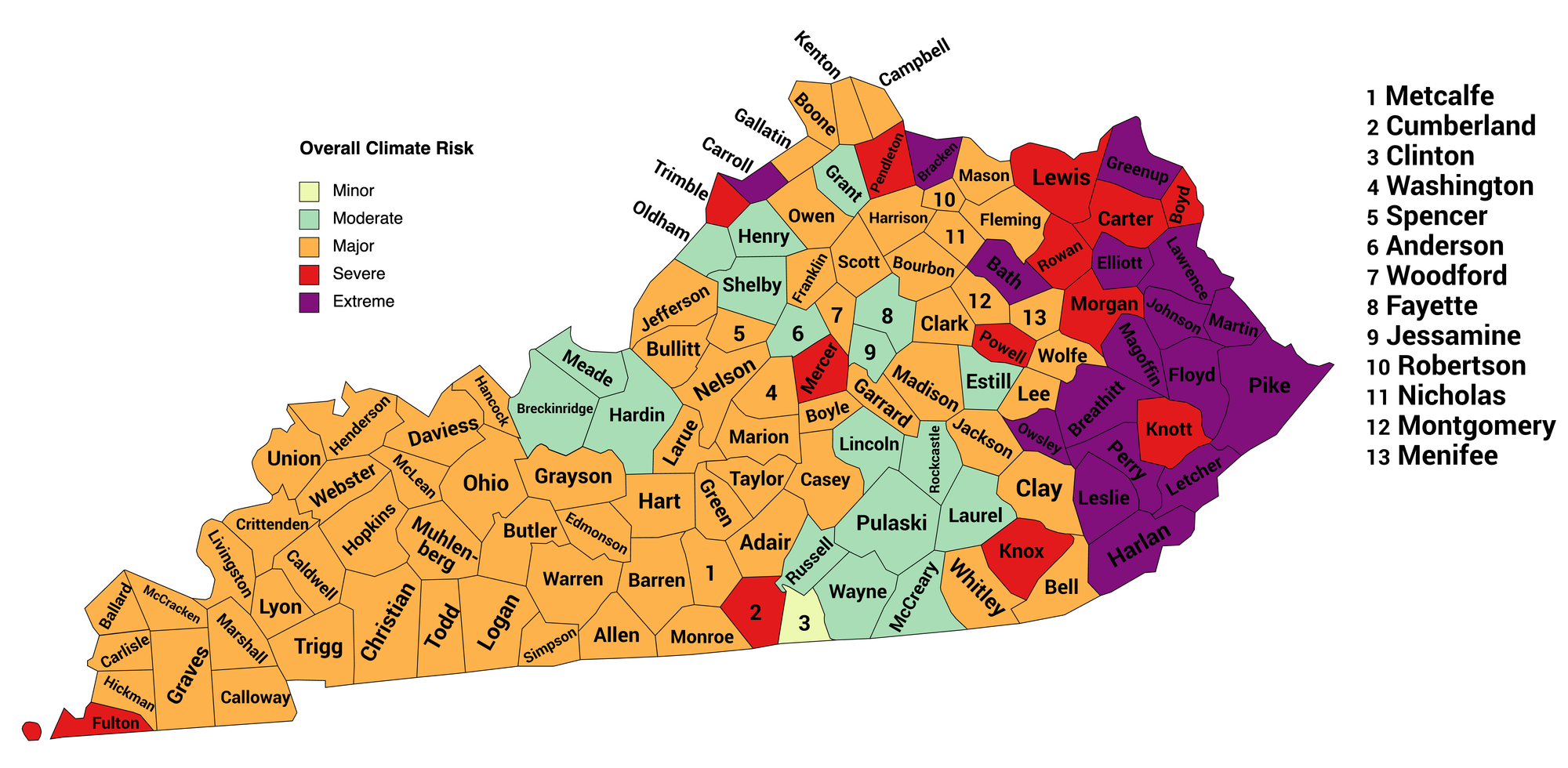The final article in the climate risk series
This is the final article in our climate risk series. In the first four articles, we used the data from the First Street Foundation to look at these four risks:
Now that we have laid out the risk to our counties from each of those four climate change risks, it’s time to paint the overall picture. What is our state’s overall risk level?
Showing the risk for individual factors was relatively easy, as First Street had already given us the underlying data and the five risk levels: Minor, Modest, Major, Severe, and Extreme. But how do you take those four risks and five risk levels and come up with an overall risk for each county?
Being the stats nerd that I am, I played around with various statistical approaches to the problem. But, after some discussion with Dr. Jeremy Porter, the Head of Climate Implications for First Street, I decided on a very simple metric: the overall risk level for a given county would the highest risk they had in any of the four categories.
Upon reflection, this makes total sense. If a county is at Severe risk for flooding, for example, then they have a Severe risk from climate change. The other three factors are irrelevant.
Map of Climate Change Risk across Kentucky
So, having explained the rationale, here is the map.

Overall Risk Data Table
And here is the underlying data. You can sort the table by clicking on a column header.
| County | Flood Risk | Fire Risk | Wind Risk | Heat Risk | Overall |
|---|---|---|---|---|---|
| Adair | 2 | 2 | 2 | 3 | 3 |
| Allen | 2 | 1 | 2 | 3 | 3 |
| Anderson | 2 | 1 | 1 | 2 | 2 |
| Ballard | 2 | 1 | 2 | 3 | 3 |
| Barren | 3 | 1 | 2 | 3 | 3 |
| Bath | 5 | 2 | 2 | 2 | 5 |
| Bell | 3 | 3 | |||
| Boone | 3 | 1 | 1 | 2 | 3 |
| Bourbon | 3 | 1 | 1 | 2 | 3 |
| Boyd | 4 | 2 | 1 | 2 | 4 |
| Boyle | 3 | 1 | 2 | 2 | 3 |
| Bracken | 5 | 1 | 1 | 2 | 5 |
| Breathitt | 5 | 3 | 2 | 2 | 5 |
| Breckinridge | 2 | 1 | 2 | 2 | 2 |
| Bullitt | 2 | 1 | 1 | 3 | 3 |
| Butler | 2 | 1 | 2 | 3 | 3 |
| Caldwell | 2 | 1 | 2 | 3 | 3 |
| Calloway | 2 | 1 | 2 | 3 | 3 |
| Campbell | 3 | 1 | 1 | 2 | 3 |
| Carlisle | 2 | 1 | 2 | 3 | 3 |
| Carroll | 5 | 1 | 1 | 2 | 5 |
| Carter | 4 | 3 | 1 | 2 | 4 |
| Casey | 3 | 2 | 1 | 2 | 3 |
| Christian | 2 | 1 | 2 | 3 | 3 |
| Clark | 3 | 1 | 1 | 2 | 3 |
| Clay | 3 | 1 | 3 | ||
| Clinton | 1 | 1 | |||
| Crittenden | 3 | 1 | 2 | 3 | 3 |
| Cumberland | 4 | 2 | 1 | 3 | 4 |
| Daviess | 2 | 1 | 1 | 3 | 3 |
| Edmonson | 2 | 1 | 2 | 3 | 3 |
| Elliott | 5 | 3 | 1 | 2 | 5 |
| Estill | 2 | 2 | |||
| Fayette | 2 | 1 | 1 | 2 | 2 |
| Fleming | 3 | 2 | 2 | 2 | 3 |
| Floyd | 5 | 3 | 1 | 2 | 5 |
| Franklin | 3 | 1 | 1 | 2 | 3 |
| Fulton | 4 | 1 | 2 | 3 | 4 |
| Gallatin | 3 | 1 | 1 | 2 | 3 |
| Garrard | 3 | 1 | 2 | 2 | 3 |
| Grant | 2 | 1 | 1 | 2 | 2 |
| Graves | 2 | 1 | 2 | 3 | 3 |
| Grayson | 2 | 1 | 2 | 3 | 3 |
| Green | 2 | 1 | 2 | 3 | 3 |
| Greenup | 5 | 3 | 1 | 2 | 5 |
| Hancock | 3 | 1 | 1 | 3 | 3 |
| Hardin | 2 | 1 | 1 | 2 | 2 |
| Harlan | 5 | 3 | 1 | 2 | 5 |
| Harrison | 3 | 1 | 1 | 2 | 3 |
| Hart | 3 | 1 | 2 | 3 | 3 |
| Henderson | 2 | 1 | 2 | 3 | 3 |
| Henry | 2 | 2 | 2 | ||
| Hickman | 2 | 1 | 2 | 3 | 3 |
| Hopkins | 3 | 1 | 2 | 3 | 3 |
| Jackson | 3 | 3 | |||
| Jefferson | 3 | 1 | 1 | 3 | 3 |
| Jessamine | 2 | 1 | 1 | 2 | 2 |
| Johnson | 5 | 3 | 1 | 2 | 5 |
| Kenton | 3 | 1 | 1 | 2 | 3 |
| Knott | 4 | 3 | 4 | ||
| Knox | 4 | 3 | 1 | 2 | 4 |
| Larue | 3 | 1 | 1 | 2 | 3 |
| Laurel | 2 | 2 | 1 | 2 | 2 |
| Lawrence | 5 | 3 | 1 | 2 | 5 |
| Lee | 3 | 3 | |||
| Leslie | 5 | 4 | 1 | 2 | 5 |
| Letcher | 5 | 3 | 1 | 2 | 5 |
| Lewis | 4 | 2 | 1 | 2 | 4 |
| Lincoln | 2 | 1 | 2 | 2 | 2 |
| Livingston | 2 | 1 | 2 | 3 | 3 |
| Logan | 3 | 1 | 2 | 3 | 3 |
| Lyon | 3 | 1 | 2 | 3 | 3 |
| Madison | 3 | 1 | 2 | 2 | 3 |
| Magoffin | 5 | 5 | 2 | 2 | 5 |
| Marion | 3 | 1 | 2 | 2 | 3 |
| Marshall | 3 | 1 | 2 | 3 | 3 |
| Martin | 5 | 3 | 1 | 2 | 5 |
| Mason | 3 | 1 | 1 | 2 | 3 |
| McCracken | 2 | 1 | 2 | 3 | 3 |
| McCreary | 2 | 2 | 2 | 2 | 2 |
| McLean | 2 | 1 | 2 | 3 | 3 |
| Meade | 2 | 1 | 1 | 2 | 2 |
| Menifee | 3 | 2 | 3 | ||
| Mercer | 4 | 1 | 2 | 2 | 4 |
| Metcalfe | 2 | 1 | 2 | 3 | 3 |
| Monroe | 2 | 2 | 2 | 3 | 3 |
| Montgomery | 3 | 1 | 2 | 2 | 3 |
| Morgan | 4 | 3 | 2 | 2 | 4 |
| Muhlenberg | 3 | 1 | 2 | 3 | 3 |
| Nelson | 3 | 1 | 1 | 3 | 3 |
| Nicholas | 3 | 1 | 1 | 2 | 3 |
| Ohio | 2 | 1 | 2 | 3 | 3 |
| Oldham | 2 | 1 | 1 | 2 | 2 |
| Owen | 3 | 1 | 1 | 2 | 3 |
| Owsley | 5 | 3 | 1 | 2 | 5 |
| Pendleton | 4 | 1 | 1 | 2 | 4 |
| Perry | 5 | 4 | 1 | 2 | 5 |
| Pike | 5 | 3 | 1 | 2 | 5 |
| Powell | 4 | 2 | 2 | 2 | 4 |
| Pulaski | 2 | 1 | 2 | 2 | 2 |
| Robertson | 3 | 1 | 1 | 2 | 3 |
| Rockcastle | 2 | 1 | 2 | ||
| Rowan | 4 | 2 | 2 | 2 | 4 |
| Russell | 2 | 1 | 2 | 2 | 2 |
| Scott | 3 | 1 | 1 | 2 | 3 |
| Shelby | 2 | 1 | 1 | 2 | 2 |
| Simpson | 2 | 1 | 2 | 3 | 3 |
| Spencer | 3 | 1 | 1 | 2 | 3 |
| Taylor | 3 | 1 | 2 | 3 | 3 |
| Todd | 2 | 1 | 2 | 3 | 3 |
| Trigg | 2 | 1 | 2 | 3 | 3 |
| Trimble | 4 | 1 | 1 | 2 | 4 |
| Union | 2 | 1 | 2 | 3 | 3 |
| Warren | 2 | 1 | 2 | 3 | 3 |
| Washington | 3 | 1 | 2 | 2 | 3 |
| Wayne | 2 | 2 | 2 | 2 | 2 |
| Webster | 2 | 1 | 2 | 3 | 3 |
| Whitley | 3 | 3 | 1 | 2 | 3 |
| Wolfe | 3 | 3 | |||
| Woodford | 3 | 1 | 1 | 2 | 3 |
Notes and Conclusions
A couple of notes about the map and the data.
- There are some counties that are missing data. Clinton County, for example, is the only county in the state at a Minor risk level from climate change. But, if you look at the data for that county, you see that they are missing data for fire, wind, and heat. Since almost all other counties in the state are at risk from heat, Clinton County probably is as well.
- Note that the ratings are based on a national scale. So, our heat numbers are suppressed to some extent, because while our heat risk is significant, it’s less than Arizona or the Gulf Coast.
People who want to minimize our risk from climate change like to say “Well, at least we’re not Florida or Arizona.” That is true. It’s also not relevant. If half your house is on fire, it’s the height of stupidity to ignore it because your neighbor’s entire house is on fire.
The climate crisis is here, and is only going to get worse. Because of the inaction of almost all our elected officials, it is too late to prevent it. There are only two remaining actions that we must take:
- Do what we can to minimize the damage.
- And at the same time, prepare for the worst-case scenarios.
As citizens, we must demand that our elected officials stop denying there is a problem, stop mouthing platitudes while doing nothing, and stop being cowards about facing the risk. We must demand, at every level, that they do what any responsible public servant would do: assess the risk to those you swore to serve, then prepare for that risk.
Anything less, in the face of overwhelming evidence of the coming crisis, is criminal negligence of duty.
--30--








